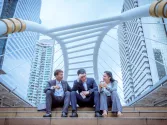The Top 4 things to consider when picking a new location for your QSR - Part 3: The shopping centre or mall site
By Peter Buckingham A QSR normally fits into one of 4 categories:
· Free Standing with Drive Thru (FSDT)
· InLine
· MALL
· CBD
Each has a series of Drivers to consider and these vary obviously depending on the type of store your wish to open. In this episode, I shall address the MALL or Shopping Centre stores.
There are a couple of QSR options now available in shopping centres. The largest group would be the typical food court stores, obviously surrounding communal seating. The second type is a one off store, not in the food court but inside the mall. The third type is on the outside of the mall, so it can trade whether the mall is open or not. This is a very good option where you do a large amount of take away, and need to trade longer than the Mall may be open.
Generators – the power of the Shopping Centre
Shopping Centres are measured by the Property Council of Australia in a few ways that make sense to compare one mall against another.
The first variable is GLAR or Gross Leasable Area Retail. This is basically how many Square Metres of space they are leasing out. This leads to the definitions of different types of Shopping Centres:
Super Regional – over 85,000 sq m
Major Regional – 50,000 – 85,000 sq m
Regional - 30,000 – 50,000 sq m
Sub – Regional - 10,000 – 30,000 sq m
Neighbourhood - Less than 10,000 sq m
Your big centres such as Chadstone, Castle Hill, Bondi Junction, Marion and Pacific Fair all qualify as Super Regional shopping centres. There are around 15 – 20 Super Regional shopping centres across Australia.
The next measurement is MAT or Moving Annual Turnover, or what is the total $ transacted through the shopping centre in a 12 month period. This is collected as there is normally a condition in the lease that you must provide the owner your sales figures, which they aggregate and report. The largest super regional shopping centres are now reporting MAT’s in excess of 1billion dollars.
The last variable that is simple to consider is the Pedestrian figure. This is again reported by the shopping centres as a total number of people per year that have visited the shopping centre. Many large super regionals are reporting numbers around 15 million to 20 million, however you do need to be aware of other issues affecting this. For example Melbourne Central reports over 30,million, which is mainly due to it being situated above a Melbourne central railway station, and many people are just passing on their way to or from work.
In summary, understanding the size and power of the shopping centre is in my view the most important factor. In most cases, big is beautiful, but be prepared to pay the higher rental.
Store Suitability
In a shopping mall this is pretty much a function of size, window frontage, whether you are on a corner or not, and to an extent being at ground level with easy access. Store suitability is having the right size and shape of store for what you are selling (and rent you are paying). If you need 80 sq m for your coffee shop, it is no good having 120 sq m. if you are not likely to use all the space. If you need to display your goods in the window, it is no good having a 3 metre frontage, with the door taking up the first 1.5m!
I would like to break this into 3 sections:
1. General QSR’s in the Mall, but not in the food court, generally is more of the coffee and cake type of store. These stores often have some outside seating and aim more for the customer to sit down to consume their goods. These stores need to be the right size, often have good visibility, such as on a corner within the mall and be allowed to put up good signage and colour to attract the clientele.
2. The food court store is all about size and frontage so it can be seen, and can display the food for sale and still handle the rapid lunchtime traffic. Most food court stores are around 8 m across, with kitchen space behind for the food preparation.
3. The outside store is often larger with its own seating, but most important is that when the Mall closes, you can close and lock the access into the mall, and still operate with take away, eat in and delivery. This also gives good parking for the delivery vehicles and customers. Examples of this are “The Pines” in Melbourne, and I did notice quite a lot of centres like this in New Zealand.
There are definite brands that attract people into their area such as McDonalds and KFC, so being near them (if possible) has some advantage. Whether in a food court, or on the outside, these act as generators to your business.
If your concept allows you to work from a kiosk such as Muffin Break or Gloria Jeans, then you can find great locations in the main traffic stream near the entrance.
Pedestrian Traffic
For a QSR to sell to customers, the customers must be coming past. Shopping Centres are reluctant to give you pedestrian traffic information, except to tell you which entrance they say have the most traffic. Funny enough, it always seems to be the entrance right near where you are considering!
I find it really easy to use counters, and spend some time taking 5 minute counts at different places. Make a line across the traffic flow, and just count for 5 minutes ALL persons who walk past in either direction. Go and do that in a few areas, probably coming back to do each one a second time say ½ an hour later. It is amazing how it can clarify your views on pedestrian traffic.
Obviously the shopping centre owners have their own numbers on these things, and they will use those to justify higher rentals. I can only suggest that the vacant site down the side corridor with the low rental is there because it does NOT get much passing traffic. In my last episode (on Inlines) I did refer to Impulse vs. Destination, and this applies exactly the same whether you are on a shopping strip or in a Mall.
Within a food court you can see where the pedestrian traffic is coming from and to where it is heading. If a food court is square or rectangular, you can often see quiet sections tucked away in corners, and the busiest sections near the main entrance. Quite often one side of the food court is far stronger due to the tenants, and the other side is quieter. Again, using a counter to measure pedestrian traffic in maybe 2 minute lots at the busiest times will quickly reveal the quiet corners of the food court.
Demographics
The fourth is the demographics. It is no good having a store selling one product range when either there are few people in the area, or they are not likely to be your customer. Whilst companies like ours can provide detailed demographic information, you can always look up any area in Australia yourself on the ABS website, www.abs.gov.au and then look for Census Data, and then Quikstats. You can put in a postcode or suburb, and find out from the Census 2011 about that area.
The demographics really go back to the shopping centre you are considering in general. In many cases the shopping centre is built on the edge of development, and will take some years to have a large enough base population to support all the tenants. A Coles or Woolworths will receive a very low rent, and they can ramp up or down their costs (especially staffing) if the store is trading slowly. This may be that they only run 2 cash register most of the time where they actually have built 6 or 10. You cannot survive in this environment and may go broke waiting for the population to finally arrive over the next 10 years.
Also think in terms of what you are selling, the pricing point and who you are selling to. If your average meal price point is very high, then selling into low socio economic areas is probably less attractive than high socio economic areas. If you are selling kids meals and ice cream, then young kids and their parents should be the best target audience.
A Target Market Index is one way of putting together 2 or 3 demographic variables to see which areas are best for what you are selling.
Summary
In summary, my 4 top things for consideration for a QSR inside a Mall or Shopping Centre are:
1. Generators – The Power of the Shopping Centre
2. Store Suitability
3. Pedestrian traffic
4. Demographics



























